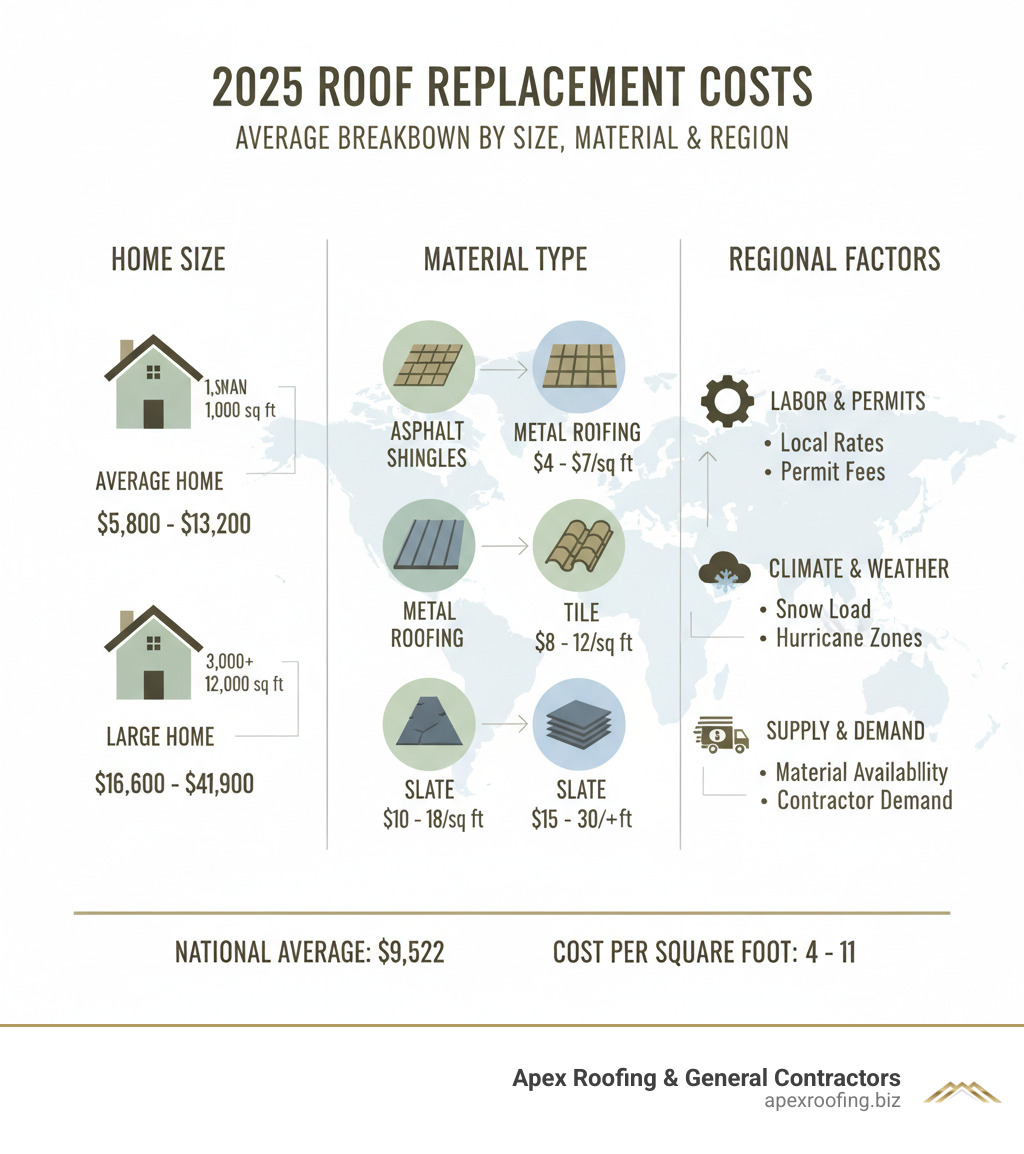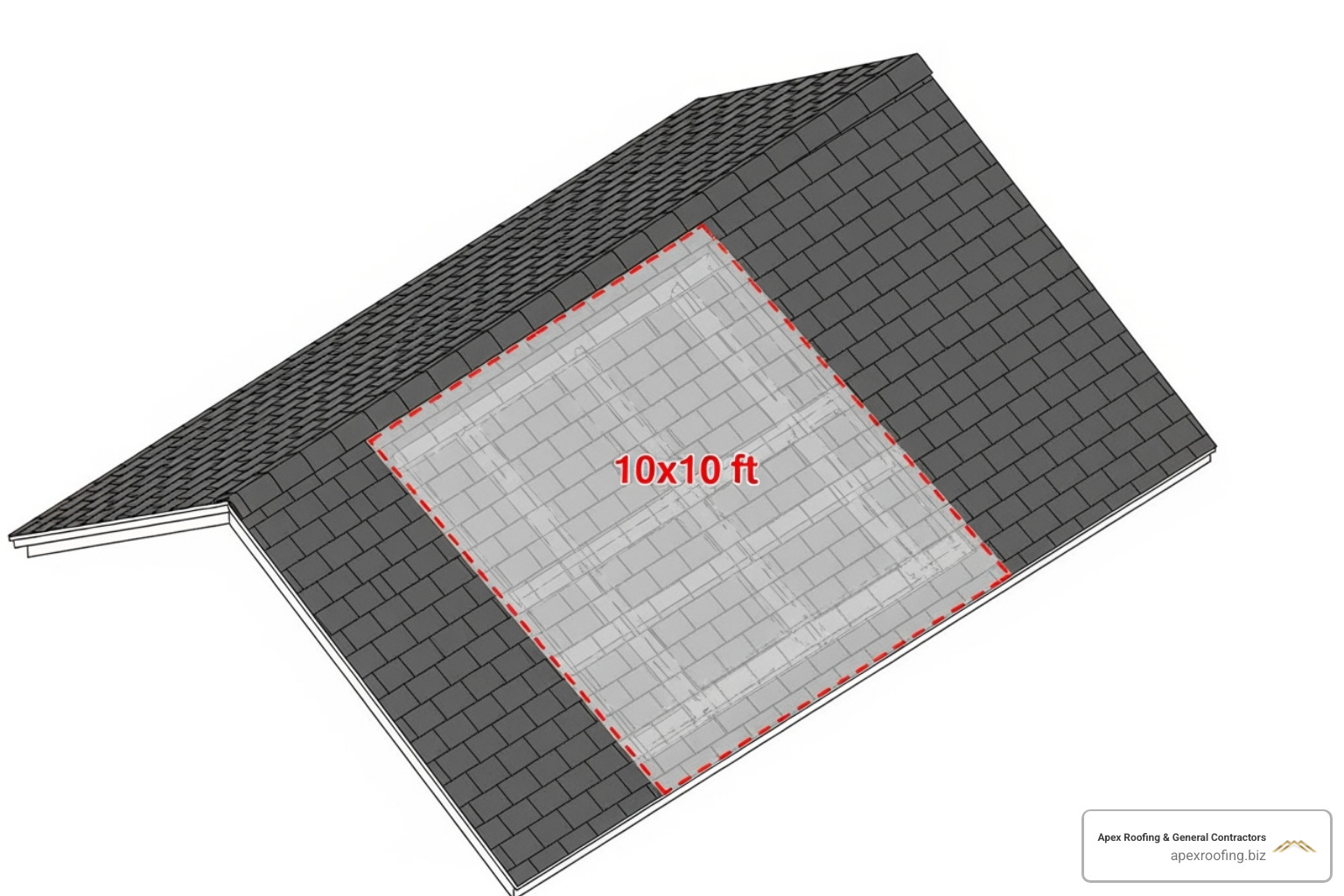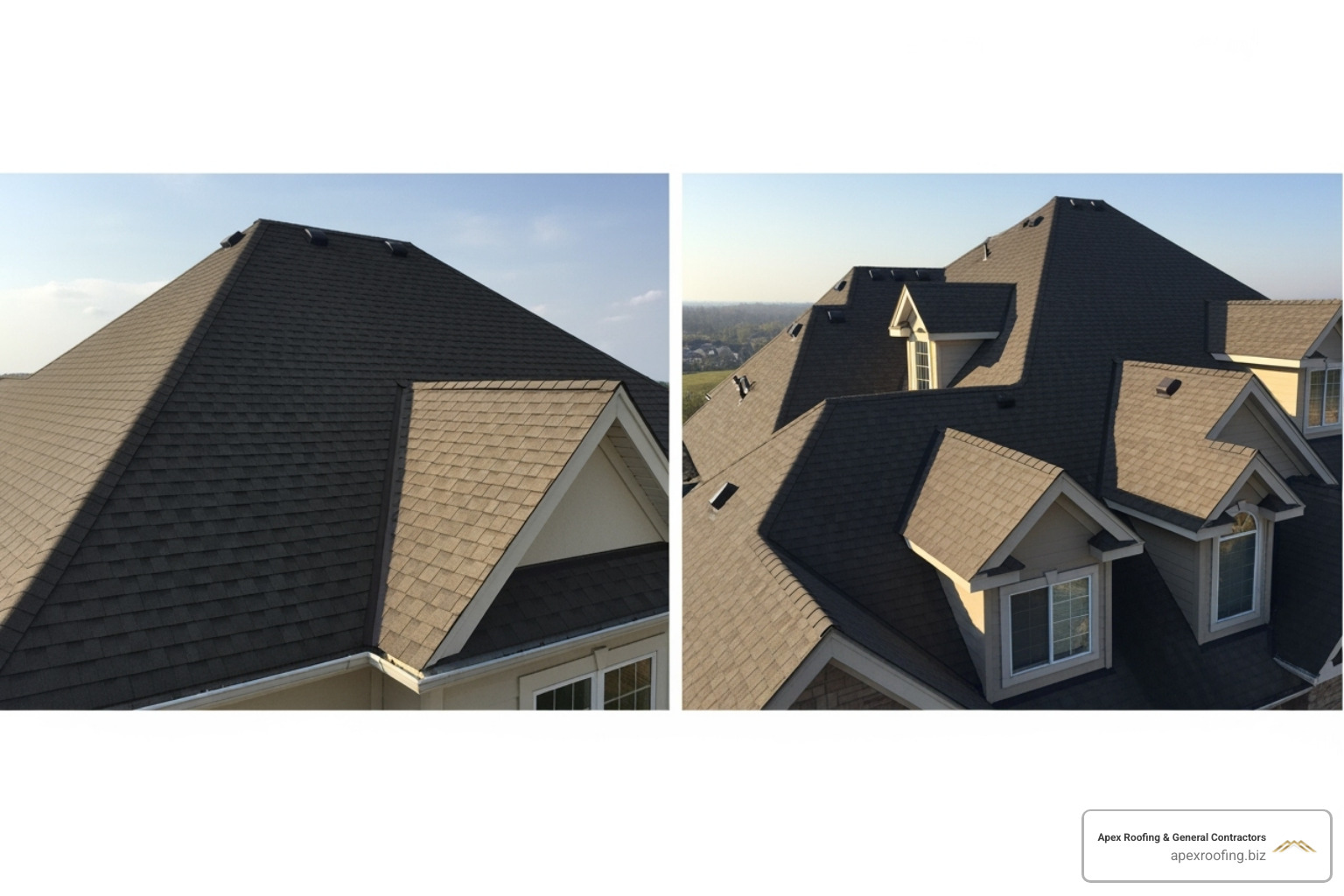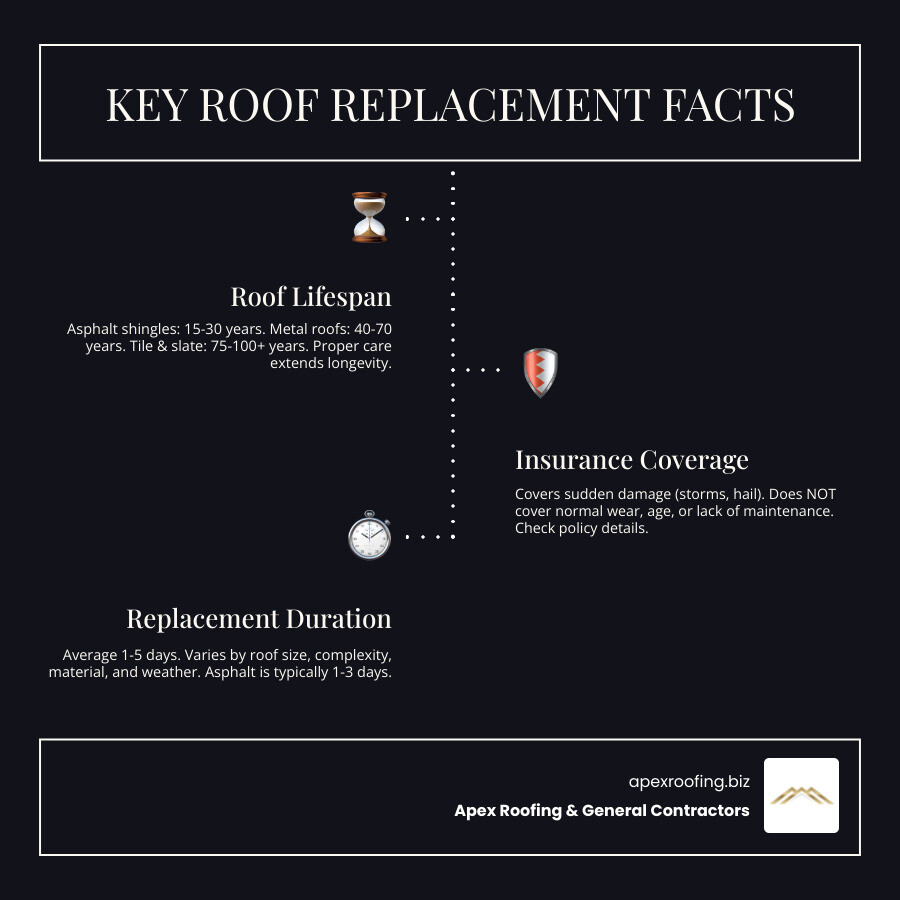Why Understanding Roof Replacement Costs Matters for Your Home Investment
The average roof replacement cost ranges from $9,522 nationally, with most homeowners spending between $5,868 and $13,214. However, your actual cost depends on several key factors that can push your project well above or below this range. For clear, local guidance from a trusted San Antonio roofing company, explore our homepage.
Quick Cost Overview:
- National Average: $9,522
- Typical Range: $5,868 – $13,214
- Cost Per Square Foot: $4 – $11
- Small Homes (1,000 sq ft): $3,500 – $6,700
- Large Homes (3,000+ sq ft): $16,600 – $41,900
Replacing a roof demands a big investment from homeowners, but it’s one of the most critical decisions you’ll make for your property. A new roof protects your family, increases your home’s value by up to 15%, and can provide a return on investment between 60% to 85%. Yet many San Antonio homeowners feel overwhelmed by conflicting price quotes and hidden fees.
The roofing industry has seen major price changes, with residential roofing spending projected to grow at an 8.2% annual rate and reach $15 billion by 2025. Understanding what drives these costs helps you make informed decisions and avoid expensive surprises. Whether you need a complete roof replacement or are just planning ahead, knowing the real numbers puts you in control.
As Carlos Yzaguirre, President of Apex Roofing & General Contractors, I’ve helped hundreds of San Antonio homeowners steer average roof replacement cost decisions since co-founding our company in 2022. My experience has shown that informed homeowners who understand pricing factors make better choices and avoid costly mistakes.

What is the Average Roof Replacement Cost Nationally?
If you’re wondering about the average roof replacement cost across the United States, you’re looking at around $9,522 for a typical project. But here’s the thing – that number is just the starting point of your research. Most homeowners actually spend somewhere between $5,868 and $13,214, and there’s a good reason for this wide range.
Every roof tells its own story. Your neighbor’s simple ranch-style home will cost significantly less to reroof than a Victorian house with multiple dormers and steep angles. When you’re ready to move forward with your project, getting a professional assessment from experienced roofing contractors helps you understand exactly where your home falls within this range.
The cost breakdown usually falls between $4 and $11 per square foot. Now, if you’re new to roofing terminology, contractors don’t actually measure your roof in individual square feet. Instead, they use something called a “roofing square” – which equals exactly 100 square feet. Think of it as a 10-foot by 10-foot section of your roof. When a contractor gives you a quote “per square,” you’ll multiply that price by however many squares your roof contains.

Understanding Cost Per Square Foot
That $4 to $11 per square foot range isn’t random – it reflects the reality of how roofing projects work. Contractors rely on this metric because it accounts for both the materials going on your roof and the skilled labor needed to install them properly.
Material costs make up a huge portion of this per-square-foot calculation. If you choose basic asphalt shingles, you’re looking at the lower end of the price spectrum – maybe $3 to $7 per square foot installed. But upgrade to metal roofing, and you’re suddenly in the $7 to $13 range. Go all-out with premium slate, and you could hit $15 to $30 per square foot or even higher.
Labor costs vary just as much, depending on what your roof demands. A straightforward gable roof on a single-story home? That’s relatively quick work. But add some steep angles, multiple levels, or heavy materials that require special handling, and your labor costs per square foot climb accordingly. Local wage rates in your area also play a role – what costs $50 per hour in one city might be $75 in another.
Average Cost by Home Size
Your home’s size gives you a solid starting point for budgeting, though remember that your roof area is usually larger than your home’s footprint. Thanks to overhangs and roof pitch, most roofs measure about 1.1 to 1.2 times your home’s heated square footage.
A 1,500 square foot home typically sees roof replacement costs between $6,240 and $31,415. That’s quite a spread, but it makes sense when you consider the difference between basic asphalt shingles and premium materials like tile or metal.
For a 2,000 square foot home, expect to budget anywhere from $9,858 to $41,822. Most homeowners with standard asphalt shingles land in the $7,000 to $11,000 range, while those choosing architectural shingles or metal roofing often see costs between $11,000 and $24,000.
Larger homes around 3,000 square feet command significantly higher investments, typically ranging from $16,600 to $41,900. If you’re considering premium materials like slate for a home this size, your budget needs to accommodate $24,000 to $60,000 or potentially more.
The key takeaway? Your roof replacement cost depends on much more than just your home’s size. The materials you choose, your roof’s complexity, and your local market all play major roles in determining your final investment.
Key Factors That Influence Your Final Price
Understanding what drives your average roof replacement cost beyond the national average makes all the difference in planning your project. Every roof tells a different story, and yours has unique characteristics that will shape your final investment.
Think of it this way: two identical houses side by side could have completely different roof replacement costs. One might have a simple design with basic asphalt shingles, while the other features multiple dormers, skylights, and premium materials. The difference? Sometimes tens of thousands of dollars.
Roofing Materials: Cost vs. Lifespan
Your material choice is the single biggest factor affecting your average roof replacement cost. It’s also where you’ll see the most dramatic differences in both upfront investment and long-term value.
| Material Type | Average Cost Per Sq. Ft. (Installed) | Average Lifespan |
|---|---|---|
| Asphalt Shingles | $3 – $7 | 15 – 30 years |
| Metal Roofing | $7 – $30 | 40 – 70+ years |
| Tile (Clay/Concrete) | $10 – $20 | 75 – 100+ years |
| Slate | $15 – $42 | 75 – 200+ years |
Asphalt shingles remain the go-to choice for most homeowners, and for good reason. They offer solid protection at a budget-friendly price, typically lasting 15 to 30 years in our Texas climate. Architectural shingles, a step up from basic 3-tab versions, provide better wind resistance and curb appeal. If you’re considering replacing asphalt shingles, you’ll find they strike the perfect balance between cost and performance for most San Antonio homes.
Metal roofing has gained serious popularity in recent years, especially here in Texas where energy efficiency matters. Yes, you’ll pay more upfront – sometimes double the cost of asphalt – but metal roofs can last 40 to 70 years or more. They reflect heat beautifully, potentially lowering your cooling costs, and they’re incredibly durable against hail and high winds.
Tile roofs bring that classic elegance many homeowners love, particularly clay tiles that complement our southwestern architecture. These premium materials can last 75 to 100+ years, making them a true lifetime investment. However, their weight often requires structural reinforcement, which adds to your overall project cost.
Slate represents the pinnacle of roofing luxury and longevity. With lifespans stretching from 75 to over 200 years, slate roofs can literally outlast the homes they protect. The hefty price tag reflects not just the premium material but also the specialized installation expertise required.
How Roof Size, Pitch, and Complexity Affect the Average Roof Replacement Cost
Your roof’s physical characteristics play a huge role in determining your final cost, often in ways that surprise homeowners.
Roof size isn’t as straightforward as it seems. Your actual roof surface area typically runs 1.1 to 1.2 times larger than your home’s footprint. Those overhangs, eaves, and the roof’s slope all add square footage – and cost.
Roof pitch – the steepness of your roof – directly impacts both safety requirements and installation difficulty. A steep roof means contractors need more safety equipment, work more slowly, and face greater challenges during installation. This can add $1,000 to $3,000 to your project cost compared to a standard-pitch roof.
Complexity factors are where costs can really climb. Every dormer, valley, skylight, and chimney requires precise cutting, custom flashing, and careful sealing. These features create what contractors call “penetrations” and “transitions” – fancy terms for areas that need extra attention and materials. A simple ranch-style home might have a straightforward installation, while a Victorian with multiple gables, dormers, and architectural details could take twice as long and cost significantly more.

Understanding Labor and Additional Fees
Labor typically represents about 60% of your total roof replacement cost, though this can vary based on material choice and project complexity. But labor is just one piece of the puzzle – several additional fees contribute to your final investment.
Tear-off costs for removing your old roof can range from $1 to $5 per square foot. If your home has multiple layers of old shingles (common in older homes), expect the higher end of this range. Each additional layer means more time, more labor, and more debris to haul away.
Debris disposal is often overlooked in initial estimates but can add $500 to $1,500 to your project. All that old roofing material has to go somewhere, and landfill fees have increased significantly in recent years.
Permit costs vary widely by location, typically running $100 to $1,400. Here in San Antonio, permits ensure your new roof meets current building codes and safety standards. Inspection fees are usually tied to permits, with local authorities checking the work at various stages.
As a company committed to quality and compliance, we always ensure your project adheres to local San Antonio roofing codes. This attention to detail protects your investment and ensures your new roof meets all safety requirements for our Texas climate.
Roof Replacement vs. Repair: Which is More Cost-Effective?
When your roof shows signs of wear or damage, you face an important financial decision: repair the problem areas or invest in a complete replacement? The answer isn’t always obvious, but understanding the key indicators can save you thousands of dollars and prevent headaches down the road.
The decision often comes down to three main factors: the extent of damage, your roof’s age, and how long you plan to stay in your home. Sometimes what looks like a minor issue on the surface actually signals deeper problems that make repairs a temporary band-aid rather than a real solution.
Signs You Only Need a Repair
Localized damage is usually your best friend when it comes to keeping costs down. If storm damage affects only a small section of your roof, a targeted repair often makes perfect financial sense. Think of it like fixing a small dent in your car versus replacing the entire vehicle.
Missing shingles from recent wind or hail damage can typically be replaced without touching the rest of your roof. This is especially true if you can match the existing material and the surrounding shingles are still in good condition. A skilled contractor can blend the repair seamlessly with your existing roof.
Minor leaks around chimneys, vents, or flashing don’t always mean disaster. These isolated issues often stem from worn caulking or loose flashing that can be repaired for a fraction of replacement cost. The key word here is “isolated” – one small leak is manageable, but multiple leaks tell a different story.
A helpful rule of thumb: consider repair if less than 25% of your roof shows damage, the repair cost stays under 30% of a full average roof replacement cost, and your roof is less than 20 years old. These numbers aren’t set in stone, but they provide a solid starting point for your decision.
Signs You Need a Full Replacement
Roof age of 20+ years is often the writing on the wall, even when damage seems manageable. Most asphalt shingle roofs reach the end of their effective life between 15 and 30 years. At this point, individual repairs become like putting new tires on a car with a failing engine – you’re addressing symptoms rather than the real problem.
Widespread granule loss shows up as bare spots on your shingles or excessive granules collecting in your gutters. These granules protect your shingles from UV damage, and once they’re gone, your roof becomes vulnerable to rapid deterioration. It’s nature’s way of telling you that time is running out.
Multiple leaks appearing in different areas of your home signal systemic failure rather than isolated incidents. Chasing these leaks with individual repairs often costs more in the long run than addressing the underlying problem with a complete replacement.
Making the right choice between roof repair or a full replacement requires an honest assessment of your roof’s condition and your long-term plans. A thorough professional inspection can reveal issues that aren’t visible from the ground and help you make an informed decision that protects both your home and your wallet.
Budgeting and Finding a Reliable Contractor
This section provides actionable advice for homeowners to manage their budget and hire the right professional for the job. Making a wise choice here can save you thousands and ensure the longevity of your investment.
How to Save Money on Your Average Roof Replacement Cost
While a new roof is a significant investment, there are smart strategies to manage your average roof replacement cost without compromising quality. The key is knowing where to look for savings and when to spend wisely.
Getting multiple quotes is your first line of defense against overpaying. Always solicit at least three detailed, itemized estimates from different reputable contractors. This allows you to compare pricing, scope of work, and materials, ensuring you get a competitive and fair price. Be wary of bids that are significantly lower than others, as they might indicate corner-cutting or hidden costs.
Timing can save you money too. Roofing demand tends to peak in spring and summer when everyone’s thinking about home improvements. Scheduling your replacement during the fall or winter (if weather permits) can sometimes lead to better deals, as contractors may offer discounts to keep their crews busy. Consider the best season for roof replacement for your area to maximize both savings and installation conditions.
Choosing materials with high ROI might seem counterintuitive to saving money, but investing in materials with a high return on investment can pay off in the long run. A new asphalt shingle roof can provide a 59% ROI, while a metal roof can offer 48%, according to the 2024 Cost Vs. Value report. These materials not only last longer but also increase your home’s value and appeal to potential buyers.
Energy-efficient materials can also reduce utility bills, offering further savings over time. Bundling services is another smart approach – if you need other exterior work like gutter replacement, consider combining it with your roof replacement. Contractors might offer a discount for a larger project, and it simplifies coordination.
What to Look For in a Reputable Roofing Contractor
Hiring the right contractor is paramount to a successful roof replacement. Unfortunately, the roofing industry has a high failure rate, with most roofing businesses failing within 5 years. To protect your investment, you need to know what separates the professionals from the fly-by-night operators.
Licensed and insured isn’t just a nice-to-have – it’s non-negotiable. A licensed contractor proves they meet state requirements, and proper insurance (liability and workers’ compensation) protects you from financial responsibility in case of accidents or damage during the project. Don’t just take their word for it; ask to see current certificates.
Local experience and reputation matter more than you might think. Choose a contractor with a strong local presence and positive reviews. Local contractors are familiar with regional weather patterns, building codes, and have a vested interest in maintaining a good reputation within the community. They can’t just disappear to another state if problems arise.
Written, itemized estimates separate the professionals from the amateurs. A reputable contractor will provide a clear, detailed estimate that breaks down all costs: materials, labor, tear-off, disposal, permits, and any additional services. This transparency helps prevent hidden fees and ensures you understand what you’re paying for. Verbal estimates or vague quotes are red flags.
Strong warranties show a contractor’s confidence in their work. Ask about both material warranties (from the manufacturer) and workmanship warranties (from the contractor). A good contractor stands behind their work with comprehensive coverage that protects your investment for years to come.
References and portfolio give you real insight into quality and customer satisfaction. Don’t hesitate to ask for references from past clients and review a portfolio of their completed projects. A contractor who’s proud of their work will be happy to show it off.
At Apex Roofing & General Contractors, we proudly serve San Antonio, Helotes, Leon Valley, Alamo Heights, Fair Oaks Ranch, Shavano Park, Terrell Hills, and Bexar County with the certified, reliable service that homeowners deserve. Experience matters, and we’re here to prove it with every project.
Frequently Asked Questions about Roof Replacement Costs
We understand that a roof replacement brings many questions. Here are some of the most common ones we hear from homeowners, along with the straightforward answers you need to make informed decisions about your average roof replacement cost.
How long does a new roof typically last?
The lifespan of your new roof depends heavily on the material you choose, but proper installation and maintenance play crucial roles too. Think of it as buying a car – a basic model will get you where you need to go, but a premium vehicle with regular care will serve you much longer.
Asphalt shingles typically last 15 to 30 years. These workhorses of the roofing world offer solid protection at an affordable price. With regular maintenance like keeping gutters clean and addressing minor issues promptly, you can help your asphalt roof reach the higher end of this range.
Metal roofs are the marathon runners of roofing materials, often lasting 40 to 70 years or even longer. While the upfront cost is higher, many homeowners find the longevity makes metal roofing a smart long-term investment.
Tile and slate roofs are the premium options that can outlast multiple generations. These materials often exceed 75 to 100 years, with some slate roofs still protecting homes after 200+ years. When you consider their lifespan, the higher initial cost starts to make more sense.
Proper installation and consistent maintenance are crucial for maximizing your roof’s lifespan, regardless of the material. Regular inspections and prompt repairs can add years to any roof’s life.
Does homeowners insurance cover roof replacement?
This is one of the most important questions homeowners ask, and the answer isn’t always straightforward. Your coverage depends on what caused the damage and the specific terms of your policy.
Most homeowners insurance typically covers roof damage from sudden, unexpected events. If a severe storm, hail, falling tree, or fire damages your roof, your insurance will likely cover the replacement cost minus your deductible. We’ve helped many San Antonio homeowners steer insurance claims after severe weather events.
However, insurance does not cover roof replacement due to normal wear and tear, old age, or lack of maintenance. If your 25-year-old roof has simply reached the end of its natural lifespan, you’ll be responsible for the full average roof replacement cost.
The key is understanding your policy before you need it. Review your coverage details and speak with your insurance provider to know exactly what’s covered. Some policies have specific exclusions or requirements that could affect your claim.
How long does it take to replace a roof?
Most homeowners are pleasantly surprised by how quickly a professional crew can transform their roof. The average time for a residential roof replacement ranges from 1 to 5 days, though several factors influence the timeline.
Roof size and complexity are the biggest factors. A simple ranch-style home with a straightforward gable roof might be completed in just 1 to 3 days. However, a larger home with multiple dormers, steep pitches, and complex angles will naturally take longer.
Material type also affects timing. Asphalt shingles are generally the quickest to install, often completed within 1 to 3 days for an average-sized home. Heavier materials like tile or slate require specialized installation techniques and sometimes structural reinforcement, extending the project to 6 to 8 days or more.
Weather conditions can throw a wrench in even the best-planned timeline. Heavy rain, snow, or high winds will pause work for safety reasons. That’s why many contractors prefer scheduling during stable weather periods.
That while the physical installation happens quickly, the entire process including permits, inspections, and material delivery can take several weeks to coordinate. A professional contractor will walk you through the complete timeline during your consultation.

Conclusion
Your roof replacement journey doesn’t have to feel overwhelming. Understanding the average roof replacement cost is just the beginning—the real power comes from knowing what drives those numbers up or down for your specific situation.
A new roof represents far more than just protection from the elements. It’s an investment that boosts your home’s energy efficiency, dramatically improves curb appeal, and can deliver impressive returns when it’s time to sell. The national average gives you a helpful baseline, but your final price will reflect your unique choices: the materials that match your style and budget, your home’s architectural features, and the local market conditions in your area.
The key to a successful project lies in preparation and choosing the right partner. When you understand how factors like roof complexity, material quality, and seasonal timing affect costs, you’re equipped to make smart decisions that serve you well for decades to come.
At Apex Roofing & General Contractors, we believe every San Antonio homeowner deserves transparent pricing and honest guidance. We’ve built our reputation on providing certified, reliable service that puts your needs first—no surprises, no hidden fees, just straightforward expertise you can trust.
Ready to transform your home with a roof that’s built to last? Let’s discuss your vision and create a custom plan that fits your budget perfectly. Contact us today for a free estimate, or call (726) 727-7663 for a free inspection, and take the first step toward securing your home for generations to come.



